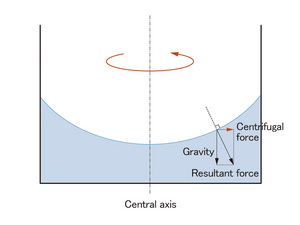Nagoya City Science Museum
TOP > Exhibition Guide > Keyword Search > Starting with "G" > gravity > Centrifugal Force
Centrifugal Force



Purpose of Exhibition
By observing the shape of the surface of a rotating water tank, you will consider the balance of gravity and centrifugal force.
Additional Knowledge
When rotating the tank in the exhibit, the water surface's shape changes. You could consider that the water is pushed outside when rotating by the centrifugal force, and that there a reason for the water surface shape of tank's water to change as it does. The shape of the water surface is shaped by resultant force of gravity and centrifugal force applied on the water, and its shape turns to a parabola which can be represented in a mathematical formula as: Y=aX^2 (articulation: X^2 =square of X).
The water surface is a quiet place without movement, the most notable of which indicates the horizon. To put it more accurately, the water surface is the plane perpendicular to the direction of force field gravity and other forces combined. Therefore, it is understood in which direction the force turns by seeing a lean of water surface.
The forces applied to the rotating water tank are gravity and centrifugal force. The gravity is pulled from the earth, straight below. Centrifugal force is created by the rotation of the water tank, and it is the force directed towards the outside. In the case of this exhibition, the direction of centrifugal force is at a right angle to gravity. Then, the resultant force of two forces is applied on the water in the tank. In this case, since the two forced directions are at right angles, the resultant force becomes skewed. Because the water surface is facing perpendicular to the force, it becomes skewed rather than facing horizontality. Moreover, since the centrifugal force is larger on the outside of the rotation, when it departs from the center of the water tank, the centrifugal force becomes larger, and the force direction of the resultant force with gravity becomes leaner. That's why it is largely inclined outside of the water tank.
The centrifugal force becomes larger in proportion to distance from the center. Therefore, inclination of the force which was made from the resultant force of the centrifugal and gravity becomes larger in proportion to the distance from the center. In this case, inclination is thought as a ratio of side and height of inclination, not as an angle. Because a curve line with inclination that becomes larger in proportion to the distance is a parabola in mathematics, it is also a parabola on the actual water surface.
Article by Yoshitaka Yamada, curator
